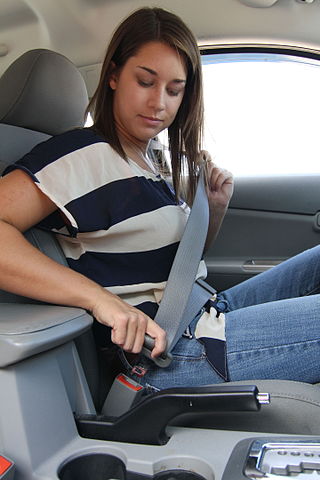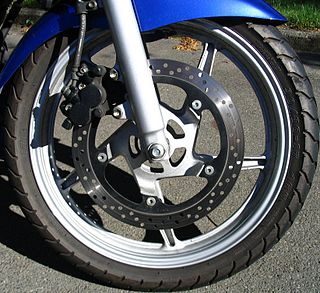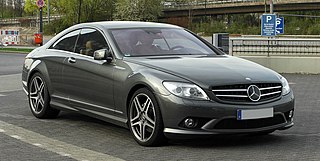
A seat belt, also known as a safety belt or spelled seatbelt, is a vehicle safety device designed to secure the driver or a passenger of a vehicle against harmful movement that may result during a collision or a sudden stop. A seat belt reduces the likelihood of death or serious injury in a traffic collision by reducing the force of secondary impacts with interior strike hazards, by keeping occupants positioned correctly for maximum effectiveness of the airbag, and by preventing occupants being ejected from the vehicle in a crash or if the vehicle rolls over.

An anti-lock braking system (ABS) is a safety anti-skid braking system used on aircraft and on land vehicles, such as cars, motorcycles, trucks, and buses. ABS operates by preventing the wheels from locking up during braking, thereby maintaining tractive contact with the road surface and allowing the driver to maintain more control over the vehicle.

A brake is a mechanical device that inhibits motion by absorbing energy from a moving system. It is used for slowing or stopping a moving vehicle, wheel, axle, or to prevent its motion, most often accomplished by means of friction.

Electronic stability control (ESC), also referred to as electronic stability program (ESP) or dynamic stability control (DSC), is a computerized technology that improves a vehicle's stability by detecting and reducing loss of traction (skidding). When ESC detects loss of steering control, it automatically applies the brakes to help steer the vehicle where the driver intends to go. Braking is automatically applied to wheels individually, such as the outer front wheel to counter oversteer, or the inner rear wheel to counter understeer. Some ESC systems also reduce engine power until control is regained. ESC does not improve a vehicle's cornering performance; instead, it helps reduce the chance of the driver losing control of the vehicle.

Advanced driver-assistance systems (ADAS) are technologies that assist drivers with the safe operation of a vehicle. Through a human-machine interface, ADAS increase car and road safety. ADAS use automated technology, such as sensors and cameras, to detect nearby obstacles or driver errors, and respond accordingly. ADAS can enable various levels of autonomous driving.

In road-transport terminology, a lane departure warning system (LDWS) is a mechanism designed to warn the driver when the vehicle begins to move out of its lane on freeways and arterial roads. These systems are designed to minimize accidents by addressing the main causes of collisions: driver error, distractions and drowsiness. In 2009 the U.S. National Highway Traffic Safety Administration (NHTSA) began studying whether to mandate lane departure warning systems and frontal collision warning systems on automobiles.

The Mercedes-Benz W221 is a chassis code of the fifth generation S-Class produced from August 2005 until June 2013.

The Mercedes-Benz C216 is the last generation for the grand tourer with name Mercedes-Benz CL-Class. It replaced the C215 platform. In 2014 it was replaced by the C217 S-Class Coupe.

Adaptive cruise control (ACC) is a type of advanced driver-assistance system for road vehicles that automatically adjusts the vehicle speed to maintain a safe distance from vehicles ahead. As of 2019, it is also called by 20 unique names that describe that basic functionality. This is also known as Dynamic cruise control.

The driver monitoring system, also known as driver attention monitor, is a vehicle safety system to assess the driver's alertness and warn the driver if needed and eventually apply the brakes. It was first introduced by Toyota in 2006 for its and Lexus' latest models. It was first offered in Japan on the GS 450h. The system's functions co-operate with the pre-collision system (PCS). The system uses infrared sensors to monitor driver attentiveness. Specifically, the driver monitoring system includes a CCD camera placed on the steering column which tracks the face, via infrared LED detectors. If the driver is not paying attention to the road ahead and a dangerous situation is detected, the system will warn the driver by flashing lights, warning sounds. If no action is taken, the vehicle will apply the brakes. This system is said to be the first of its kind.
Emergency brake can refer to:

A collision avoidance system (CAS), also known as a pre-crash system, forward collision warning system (FCW), or collision mitigation system, is an advanced driver-assistance system designed to prevent or reduce the severity of a collision. In its basic form, a forward collision warning system monitors a vehicle's speed, the speed of the vehicle in front of it, and the distance between the vehicles, so that it can provide a warning to the driver if the vehicles get too close, potentially helping to avoid a crash. Various technologies and sensors that are used include radar (all-weather) and sometimes laser (LIDAR) and cameras to detect an imminent crash. GPS sensors can detect fixed dangers such as approaching stop signs through a location database. Pedestrian detection can also be a feature of these types of systems.
Automatic braking may refer to:

The World Forum for Harmonization of Vehicle Regulations define AEBS. UN ECE regulation 131 requires a system which can automatically detect a potential forward collision and activate the vehicle braking system to decelerate a vehicle with the purpose of avoiding or mitigating a collision. UN ECE regulation 152 says deceleration has to be at least 5 metres per second squared.
Emergency Assist is a driver assistance system that monitors driver behavior by observing delays between the use of the accelerator and the brake; once a preset threshold of time has been exceeded the system will take control of the vehicle in order to bring it to a safe stop.
Intersection assistant is an advanced driver-assistance system first introduced in 2009.

The Mercedes-Benz W205 is the fourth generation of the Mercedes-Benz C-Class which was produced by Daimler AG between 2014 and 2021. The W205 C-Class was preceded by the W204 C-Class and superseded by the W206 C-Class. The fourth-generation C-Class was available in sedan (W205), station wagon/estate (S205), coupe (C205), cabriolet (A205) and long-wheelbase sedan (V205) body styles.
Pedestrian crash avoidance mitigation (PCAM) systems, also known as pedestrian protection or detection systems, use computer and artificial intelligence technology to recognize pedestrians and bicycles in an automobile's path to take action for safety. PCAM systems are often part of a pre-collision system available in several high end car manufacturers, such as Volvo and Mercedes and Lexus, and used less widely in lower end cars such as Ford and Nissan. As of 2018 using 2016 data, more than 6,000 pedestrians and 800 cyclists are killed every year in the US in car crashes. Effective systems deployed widely could save up to 50% of these lives. More than 270,000 pedestrians are killed every year in the world. An excellent analysis of technology capabilities and limitations is provided in Death of Elaine Herzberg. Pedestrian safety has traditionally taken a secondary role to passenger safety.

The Aiways U5 is an all-electric battery-powered compact crossover SUV manufactured by the Chinese company Aiways. It is the first vehicle model from this manufacturer. The production model of the U5 was publicly unveiled at the 2018 Beijing Auto Show. The car was originally previewed as the Aiways U5 ion Concept in 2018.
Automated lane keeping systems (ALKS), also described as traffic jam chauffeurs, is an autonomous driving system that doesn't require driver supervision on motorways. ALKS is an international standard set out in UN-ECE regulation 157 and amounts to Level 3 vehicle automation. It is essentially a more robust combination of adaptive cruise control (ACC) and lane centering assist (LCA). When activated, it allows the driver to do non-driving tasks until alerted otherwise.











